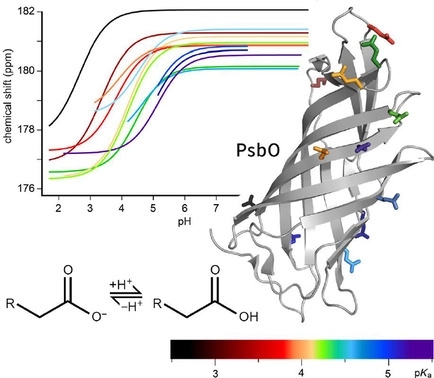
pH-Dependent Protonation of Surface Carboxylates in PsbO Enables Local Buffering and Triggers Structural Changes
L.M. Gerland; D. Friedrich; L. Hopf; E. Donovan; A. Wallmann; N. Erdmann; A. Diehl; M. Bommer, K. Buzar; M. Ibrahim M; P. Schmieder; H. Dobbek; A. Zouni; A.N. Bondar; H. Dau; H. Oschkinat*
ChemBioChem 21, 1597 - 1604 (2020)
Photosystem II (PSII) catalyzes the splitting of water, releasing protons and dioxygen. Its highly conserved subunit PsbO extends from the oxygen evolving center (OEC) into the thylakoid lumen and stabilizes the catalytic Mn 4 CaO 5 -cluster. The high conservation of accessible, negatively charged surface residues in PsbO suggests additional functions, as local pH buffer or by affecting the flow of protons. For this discussion, we provide an experimental basis by determining pK a values of water-accessible aspartate and glutamate side chain carboxyl groups using NMR. Their distribution is strikingly uneven, with high pK a values around 4.9 clustering on the luminal PsbO side and values below 3.5 on the side facing PSII. pH-dependent changes of backbone chemical shifts in the area of the lumen-exposed loops are observed, indicating conformational changes. In conclusion, we present a site-specific analysis of carboxyl group proton affinites in PsbO, providing a basis to further understand proton transport in photosynthesis.
